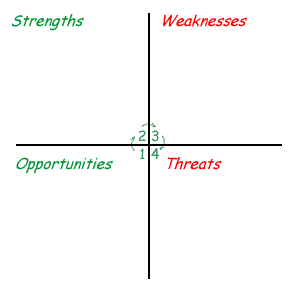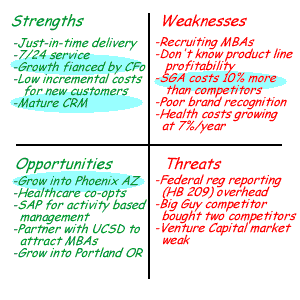SWOT Analysis
This chapter describes several techniques to use a SWOT analysis to prioritize your best strategic opportunities. If you are responsible for creating a strategic plan, take a look at the process overview.
A SWOT analysis is a method to organize your thinking on your best opportunities and core strengths. It is the framework most strategic planning teams use to analyze their firm's opportunities, how to play to your strengths, what weaknesses to fix and what are the threats you must prepare for. A SWOT analysis is straight forward, provides a method to talk through all the critical issues and will focus the strategic planning team.
As an expert facilitator and strategic planning consultant, I use several the variations for a SWOT to improve the team's strategic thinking. The SWOT was developed by Kenneth Andrews and others at Harvard in the early 1960s.
Here and on the next pages, I'll demonstrate four techniques using a SWOT: the classic SWOT, comparing market segment SWOTs side by side, a SWOT using your critical success factors and a decision matrix.
Definitions
The definition of a SWOT is:
Strengths
What do we control - resources, people, knowledge - that gives us an advantage in the marketplace? These strengths are your core competencies.
Weaknesses
What do we control but is hurting us in the marketplace? What do we need to fix?
Opportunities
Opportunities exist for everyone in the marketplace - you do not control access to an opportunity. For example, where can we create more value for our customers - a better product, quicker delivery, less costs of supplies, etc. Can we take advantage of the opportunity faster or for less costs than our competition?
Threats
A threat will prevent or make doing business very difficult. You cannot
eliminate a threat; you either mitigate it or avoid it. For example, the government changes the law and your business goes away, or customers lose interest in your product - yesterday the typewriter, now the PC.
The Classic SWOT
Most teams begin their discussions by creating lists of strengths, weaknesses,
opportunities and threats, making sure everyone's ideas are included. Then,
the list are culled and refined to the top five strengths, weaknesses, opportunities
and threats, usually by voting. Then each list is examined relative to the
others, in this order: opportunities, strengths, weaknesses, threats.
 Discuss your opportunities first Discuss your opportunities first
This is the first step identifying your strategic focus as you formulate strategy. As a strategic planning facilitator, I have the strategic planning team follow this sequence.
1. What are our best opportunities?
Start your conversations with your best opportunities? Why is it the best: timing, costs, customer perception, talent, competition response?
2. For that opportunity, which strengths can we leverage?
How well does the opportunity match our core competency, our strengths?
3. Which weaknesses must we overcome?
What do we have to fix? How quickly? Costs? Will the fix benefit other opportunities?
4. Can any threat veto our opportunity?
Is there a show stopper: a new law, a new technology, something we cannot avoid? What do we have to monitor?
Go though this discussion for each of the opportunities — you initial options.
Agree the Strategic Focus
 For this example, two opportunities have been discussed. For this example, two opportunities have been discussed.
What is common to both?
Can we kill two birds with one stone?
Will it serve our customers better?
What do we have to fix? How quickly? Costs? Will the fix benefit other opportunities?
Will we make a profit?
What will make us stronger?
What is the strategic focus?
Stepping back from the discussion, what is the most important task we need to do to be successful?
Here, to grow regionally, with little venture capital, the SGA costs need to be controlled so we can grow profitability. The strategic focus is "how to grow using internal funds." Be careful, sometimes you have to step back from the SWOT to see the big picture.

 Critical Success Factors Critical Success Factors |
|
SWOT variations
 |
|